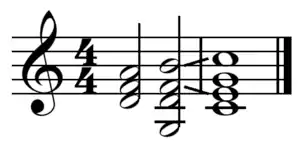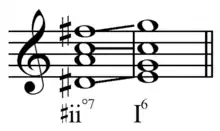Supertonic
In music, the supertonic is the second degree (![]() ) of a diatonic scale, one whole step above the tonic.[1] In the movable do solfège system, the supertonic note is sung as re.
) of a diatonic scale, one whole step above the tonic.[1] In the movable do solfège system, the supertonic note is sung as re.


The triad built on the supertonic note is called the supertonic chord. In Roman numeral analysis, the supertonic chord is typically symbolized by the Roman numeral "ii" in a major key, indicating that the chord is a minor chord (in C: D–F–A). In a minor key, it is indicated by "iio" if it is built on the a natural minor scale, indicating that the chord is a diminished chord (in C: D–F–A♭). Because it is a diminished chord, it usually appears in first inversion (iio6) so that no note dissonates with the bass note.
These chords may also appear as seventh chords: in major, as ii7 (in C: D–F–A–C), while in minor as iiø7 (in C: D–F–A♭–C) or rarely ii7. They are the second-most-common form of nondominant seventh chords.[2]

The supertonic chord normally functions as a predominant chord, a chord that naturally resolves to chord with dominant function. The supertonic chord lies a fifth above the V chord. Descending fifths are a strong basis for harmonic motion (see circle of fifths). The supertonic is one of the strongest predominants and approaches the V chord from above by descending fifth.


In major or minor, the major chord built on the lowered supertonic (♭![]() ) is called a Neapolitan chord (in C: D♭–F–A♭), notated as N6 or ♭II6, usually used in first inversion. The supertonic may be raised as part of the common-tone diminished seventh chord, ♯iio7 (in C: D♯–F♯–A–C). One variant of the supertonic seventh chord is the supertonic diminished seventh[3] with the raised supertonic, which equals the lowered third through enharmonic equivalence (in C: D♯=E♭).
) is called a Neapolitan chord (in C: D♭–F–A♭), notated as N6 or ♭II6, usually used in first inversion. The supertonic may be raised as part of the common-tone diminished seventh chord, ♯iio7 (in C: D♯–F♯–A–C). One variant of the supertonic seventh chord is the supertonic diminished seventh[3] with the raised supertonic, which equals the lowered third through enharmonic equivalence (in C: D♯=E♭).
The term supertonic may also refer to a relationship of musical keys. For example, relative to the key of C major, the key of D major (or D minor) is the supertonic.
In Riemannian theory, the supertonic is considered the subdominant parallel: Sp/T in major though sP/T in minor (A♭M).
References
- Benward & Saker (2003). Music: In Theory and Practice, Vol. I, p. 32. Seventh edition. ISBN 978-0-07-294262-0. "One step above the tonic."
- Kostka, Stefan; Payne, Dorothy (2004). Tonal Harmony (5th ed.). Boston: McGraw-Hill. p. 216. ISBN 0072852607. OCLC 51613969.
- Kitson, C. H. (2006). Elementary Harmony, p. 43. ISBN 1-4067-9372-8.
